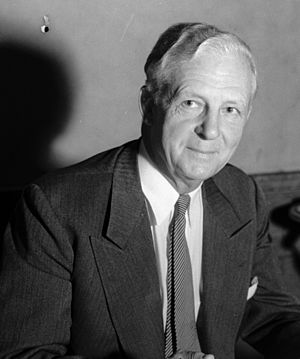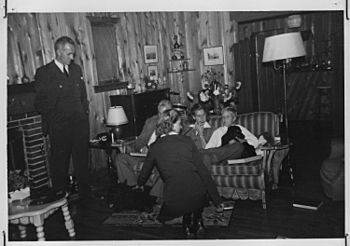Culbert Olson facts for kids
Quick facts for kids
Culbert Olson
|
|
|---|---|

Olson in 1935
|
|
| 29th Governor of California | |
| In office January 2, 1939 – January 4, 1943 |
|
| Lieutenant | Ellis E. Patterson |
| Preceded by | Frank Merriam |
| Succeeded by | Earl Warren |
| Member of the California Senate from the 38th district |
|
| In office January 7, 1935 – January 2, 1939 |
|
| Preceded by | J. W. McKinley |
| Succeeded by | Robert W. Kenny |
| Member of the Utah State Senate from the 6th district |
|
| In office January 8, 1917 – January 10, 1921 |
|
| Personal details | |
| Born |
Culbert Levy Olson
November 7, 1876 Fillmore, Utah, U.S. |
| Died | April 13, 1962 (aged 85) Los Angeles, California, U.S. |
| Political party | Democratic |
| Spouse |
Kate Jeremy
(m. 1905; died 1939) |
| Children | 3 |
| Alma mater | |
| Profession | Journalist, Lawyer |
Culbert Levy Olson (born November 7, 1876 – died April 13, 1962) was an American lawyer and politician. He was a member of the Democratic Party. Olson was involved in politics in both Utah and California. He became the 29th governor of California and served from 1939 to 1943.
Contents
Early Life and Education
Culbert Olson was born in Fillmore, Utah, on November 7, 1876. His parents were Delilah Cornelia King and George Daniel Olson. His mother was a suffragette, which means she worked for women's right to vote. She became the first woman elected to public office in Utah.
Olson's parents were members of The Church of Jesus Christ of Latter-day Saints. However, Culbert himself did not believe in God. He became an atheist when he was ten years old.
At 14, Olson left school and worked briefly as a telegraph operator. In 1890, he enrolled at Brigham Young University in Provo. There, he studied law and journalism.
Career
Early Career in Journalism and Law
After graduating in 1895 at age 19, Olson started working as a journalist. He worked for the Daily Ogden Standard. In the 1896 Presidential Election, Olson supported Democratic candidate William Jennings Bryan.
After the election, Olson moved to Michigan for a short time. He studied law at the University of Michigan. Later, he moved to Washington, D.C.. There, he worked as a newspaper writer and a secretary for the U.S. Congress. While in Washington, Olson also attended law school at George Washington University. He was allowed to practice law in Utah in 1901.
Serving in State Legislatures
Olson returned to Utah in 1901 and started a law practice in Salt Lake City. He became known for defending trade union members and people who wanted political change. In 1916, he was elected to the Utah State Senate. During his four years there, Olson helped create new laws. These laws aimed to stop child labor, provide old age pensions, and give the government more control over public services.
In 1920, Olson decided not to run for the Utah State Senate again. He moved to Los Angeles, California, and started another law practice. He gained a reputation for investigating companies that were doing illegal things. Olson continued to be involved in politics. He openly supported Progressive Party candidate Robert La Follette in the 1924 Elections. He also supported Democrat Franklin Roosevelt in the 1932 Elections.
In 1934, during the Great Depression, Olson ran for the California State Senate as a Democrat. He represented Los Angeles. During the 1934 elections, Olson supported Upton Sinclair, who was running for governor. Sinclair was a former Socialist Party member. Olson helped with Sinclair's End Poverty in California campaign. Even though Sinclair lost, Olson was elected to the State Senate.
While in the California State Senate, Olson strongly supported President Roosevelt's New Deal policies. These policies aimed to help people who were unemployed. Olson believed that large businesses were stopping progress. He wrote the Olson Oil Bill to reduce the power of oil company monopolies in the state.
With President Roosevelt's support, Olson ran for governor of California in 1938. He ran against the current governor, Frank Merriam, who was a Republican. Merriam was not very popular with people who wanted change or with union members. He was also disliked by some Republicans because of his tax changes. Olson won the election by a large amount. He was the first Democrat to become governor since 1894. This ended 40 years of Republican governors in California.
Governor of California
Olson became California's 29th governor on January 2, 1939. He was the first Democrat to hold the office in four decades. In his first speech as governor, Olson said he was inspired by people who wanted progress. He spoke about creating an economy that would provide jobs, plenty of goods, fair distribution, and security for old age.
During his oath of office, Olson refused to say "so help me God." He told Justice William H. Waste that "God couldn't help me at all, and that there isn't any such person." Instead, Olson simply said, "I will affirm."
Olson's time as governor began with difficulties. Four days after he became governor, he collapsed. Doctors found that he had a heart problem. Also, his wife, Kate Jeremy Olson, died shortly after he took office. They had been married for almost 39 years.
Unlike the previous governor, Olson worked well with the state's labor unions. In September 1939, he officially pardoned Tom Mooney. Mooney was a labor activist who had been accused of a bombing in San Francisco in 1916. Olson said there was not enough evidence against Mooney. The next month, Olson also pardoned Mooney's friend, Warren Billings.
Olson often had disagreements with the California State Legislature. Democrats who were more conservative controlled the Assembly. Business-friendly Republicans controlled the Senate. This made it hard for Olson to pass his New Deal-like policies. The Legislature was also careful about Olson's left-leaning plans. In his first year, Olson's proposed budget was cut by almost 100 million dollars. His idea for universal health insurance for everyone in California was also rejected. The Legislature also voted against raising taxes on income, banks, and companies. They also stopped Olson's plans to control lobbyists and change the state's prison system. Money for farmers was cut almost in half.
During his time as governor, Olson became more critical of the Roman Catholic Church. He was concerned about its role in the state's education system. This angered Archbishops John J. Cantwell of Los Angeles and John J. Mitty of San Francisco. Olson was a secular atheist. He was troubled when the state legislature passed two bills in 1941. One bill gave free transportation to students attending Catholic schools. The other allowed Catholic children to leave public schools early for religious classes. Olson signed the first bill into law, saying he felt great pressure from the Catholic Church. But he vetoed the second bill.
After the Japanese attack on Pearl Harbor in December 1941, the United States entered the Second World War. Many people in California worried about a Japanese invasion. Olson asked Californians to remain calm. On December 14, he spoke about racial tolerance. He said that all racial groups had promised their loyalty to the United States. He even read a telegram from a Japanese citizen. Olson tried to take away business licenses from Japanese immigrants in California. These immigrants were not allowed to become U.S. citizens.
On February 19, 1942, President Franklin Roosevelt issued Executive Order 9066. This order allowed military commanders to create zones where people could be removed. Because of this, all Japanese Americans on the West Coast were forced to move to isolated internment camps. This included American-born citizens and non-citizens.
General John L. DeWitt recommended these internments. This was difficult for Governor Olson. On February 2, 1942, after meeting with DeWitt, Olson said that a mass evacuation would not be needed. However, DeWitt continued with his plans. Olson preferred to only remove Japanese Americans from coastal areas. He also wanted adult men to work in labor camps instead of being imprisoned. Despite his earlier views, Olson fully supported the forced removal. He had always supported Roosevelt's policies. On March 6, 1942, he spoke to a U.S. House committee. He said it was dangerous to let Japanese Americans remain free. He stated, "Because of the extreme difficulty in distinguishing between loyal Japanese Americans... and those other Japanese whose loyalty is to the Mikado. I believe in the wholesale evacuation of the Japanese people from coastal California."
By the 1942 elections, Republicans accused Olson of playing politics during wartime. They pointed to his many disagreements with the State Legislature. The Republican Party chose California Attorney General Earl Warren to run for governor. Warren was a moderate Republican. He presented himself as someone who could unite liberals and conservatives during the war. He accused Olson of being too extreme and unwilling to compromise.
Olson lost to Warren by a large number of votes. In later years, Olson said his defeat was caused by "the active hostility of a certain privately owned power corporation and the Roman Catholic Church in California."
Later Career
After leaving the governorship, Olson returned to practicing law. He gained public attention again in the 1950s. This was when the Legislature voted to make Catholic schools free from real estate taxes. Olson filed a legal document to the state Supreme Court. He asked the court to explain how the state could legally exempt a religious group from taxes.
In 1957, Olson became the president of the United Secularists of America. This group was made up of secularists, atheists, and freethinkers.
Death
Culbert Olson died in Los Angeles on April 13, 1962. He was 85 years old. Olson is buried in Forest Lawn Memorial Park Cemetery in Glendale, California.


